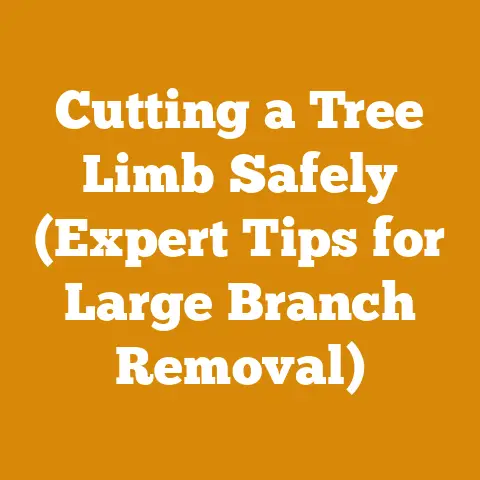Straight Shaft or Curved Shaft String Trimmer (Expert Insights)
As someone who has spent countless hours in the woods, I understand the importance of having the right tools for the job. The best choice depends on the specific needs of your region and the type of work you’ll be doing. In areas with dense vegetation and uneven terrain, a straight shaft might be preferable for its reach and power. However, for smaller yards with simpler trimming tasks, a curved shaft could offer better maneuverability. Let’s dive into the details and help you make the right decision.
Straight Shaft or Curved Shaft String Trimmer: Expert Insights
Choosing the right string trimmer can make all the difference in maintaining a neat and tidy yard. Both straight shaft and curved shaft string trimmers have their own set of advantages and disadvantages. I’ll share my experiences and insights to help you decide which type is best for your needs.
Understanding String Trimmers
Before we get into the specifics, let’s cover the basics of string trimmers. A string trimmer, also known as a weed eater or weed whacker, is a tool used to cut grass, weeds, and small brush using a rotating head with a monofilament line. It’s an essential tool for edging lawns, trimming around obstacles, and clearing overgrown areas.
Key Components of a String Trimmer
- Engine/Motor: Powers the trimmer head. Can be gas-powered, electric (corded), or battery-powered.
- Shaft: Connects the engine/motor to the trimmer head. This is where the straight vs. curved difference comes in.
- Trimmer Head: Holds the string and rotates to cut vegetation.
- Handle: Provides grip and control.
- Guard: Protects the user from flying debris.
Straight Shaft String Trimmers
Straight shaft string trimmers feature a long, straight shaft connecting the motor to the trimmer head. This design offers several advantages, making them suitable for specific types of tasks and users.
Advantages of Straight Shaft Trimmers
- Extended Reach: The straight shaft allows for greater reach, making it easier to trim under bushes, fences, and other obstacles. I’ve found this particularly useful when clearing weeds along creek banks where the vegetation is hard to reach.
- Better for Tall Users: Taller individuals often find straight shaft trimmers more comfortable to use because they don’t have to bend over as much. I’m 6’2″, and I definitely appreciate the ergonomic advantage of a straight shaft.
- Attachment Capability: Many straight shaft trimmers are designed to accept attachments, such as edgers, hedge trimmers, and pole saws. This versatility can save you money and storage space.
- Durability: Straight shaft trimmers often have a more robust construction, making them more durable and able to handle tougher jobs.
Disadvantages of Straight Shaft Trimmers
- Heavier: The longer shaft and heavier construction can make straight shaft trimmers more tiring to use for extended periods.
- Less Maneuverable: The length of the shaft can make it more difficult to maneuver in tight spaces.
- Higher Cost: Straight shaft trimmers tend to be more expensive than curved shaft models, especially those with attachment capabilities.
Ideal Uses for Straight Shaft Trimmers
- Large Properties: If you have a large yard with lots of obstacles and hard-to-reach areas, a straight shaft trimmer is a great choice.
- Commercial Use: Landscaping professionals often prefer straight shaft trimmers for their durability, power, and versatility.
- Heavy-Duty Tasks: Clearing thick brush, trimming along fences, and edging large areas are all tasks that a straight shaft trimmer can handle with ease.
Curved Shaft String Trimmers
Curved shaft string trimmers have a curved shaft that connects the motor to the trimmer head. This design offers a different set of advantages, making them suitable for different types of users and tasks.
Advantages of Curved Shaft Trimmers
- Lighter Weight: Curved shaft trimmers are typically lighter than straight shaft models, making them easier to handle and less tiring to use.
- More Maneuverable: The shorter, curved shaft allows for greater maneuverability in tight spaces and around obstacles.
- Lower Cost: Curved shaft trimmers are generally less expensive than straight shaft models, making them a good option for budget-conscious homeowners.
- Easier to Store: The more compact design of curved shaft trimmers makes them easier to store in garages or sheds.
Disadvantages of Curved Shaft Trimmers
- Limited Reach: The curved shaft limits your reach, making it more difficult to trim under bushes and other obstacles.
- Less Comfortable for Tall Users: Taller individuals may find curved shaft trimmers uncomfortable to use because they have to bend over more.
- Fewer Attachment Options: Curved shaft trimmers typically don’t offer the same attachment options as straight shaft models.
- Less Durable: Curved shaft trimmers are generally less durable than straight shaft models and may not be able to handle heavy-duty tasks.
Ideal Uses for Curved Shaft Trimmers
- Small to Medium-Sized Yards: If you have a smaller yard with fewer obstacles, a curved shaft trimmer is a great choice.
- Homeowners with Limited Storage Space: The compact design of curved shaft trimmers makes them ideal for homeowners with limited storage space.
- Light-Duty Tasks: Trimming grass around flower beds, edging sidewalks, and clearing light weeds are all tasks that a curved shaft trimmer can handle effectively.
Power Source: Gas, Electric, or Battery?
The power source of your string trimmer is another important factor to consider. Each type has its own pros and cons.
Gas-Powered String Trimmers
- Pros:
- High power and performance
- Cordless and portable
- Suitable for heavy-duty tasks
- Cons:
- Noisy and require maintenance
- Produce emissions
- Can be difficult to start
I’ve used gas-powered trimmers for years, especially when clearing large areas of thick brush. The power is unmatched, but the noise and maintenance can be a hassle.
Electric (Corded) String Trimmers
- Pros:
- Lightweight and easy to use
- Quiet and require minimal maintenance
- Environmentally friendly
- Cons:
- Limited by the cord length
- Less powerful than gas-powered models
- Not suitable for large properties
Electric trimmers are great for small yards where you have easy access to an outlet. They’re quiet and easy to start, but the cord can be a nuisance.
Battery-Powered String Trimmers
- Pros:
- Cordless and portable
- Quiet and require minimal maintenance
- Environmentally friendly
- Cons:
- Limited run time
- Can be expensive
- May not be as powerful as gas-powered models
Battery-powered trimmers offer a good balance of power and convenience. The run time can be a limiting factor, but the technology is constantly improving. I’ve found them particularly useful for quick touch-ups around the yard.
Ergonomics and Comfort
The ergonomics of a string trimmer can significantly impact your comfort and reduce the risk of strain and injury. Here are some factors to consider:
- Weight: Choose a trimmer that you can comfortably handle for extended periods.
- Handle Design: Look for a trimmer with an adjustable handle that allows you to find a comfortable grip.
- Vibration: Excessive vibration can cause fatigue and discomfort. Look for a trimmer with vibration-reducing technology.
- Balance: A well-balanced trimmer will be easier to control and less tiring to use.
I once spent an entire day clearing brush with a poorly balanced trimmer, and I paid the price with sore arms and shoulders for days afterward. Investing in a trimmer with good ergonomics is well worth it.
Safety Considerations
Using a string trimmer safely is crucial to prevent injuries. Here are some important safety tips:
- Wear Safety Glasses: Protect your eyes from flying debris.
- Wear Hearing Protection: String trimmers can be loud, so wear earplugs or earmuffs to protect your hearing.
- Wear Long Pants and Closed-Toe Shoes: Protect your legs and feet from flying debris and accidental cuts.
- Read the Owner’s Manual: Familiarize yourself with the trimmer’s operation and safety features.
- Keep Bystanders Away: Ensure that bystanders are at least 50 feet away from the work area.
- Inspect the Trimmer Before Use: Check for loose parts, damaged cords, or other potential hazards.
- Use Proper Cutting Techniques: Avoid swinging the trimmer wildly and keep the cutting head close to the ground.
Maintenance Tips
Proper maintenance will extend the life of your string trimmer and ensure that it operates safely and efficiently. Here are some maintenance tips:
- Clean the Trimmer After Each Use: Remove grass, weeds, and other debris from the trimmer head and engine/motor.
- Sharpen or Replace the String Regularly: Dull string will reduce cutting performance and increase the risk of breakage.
- Check and Replace Air Filters: Clean air filters will ensure that the engine/motor runs efficiently.
- Change the Oil (for Gas-Powered Trimmers): Regular oil changes will keep the engine running smoothly.
- Store the Trimmer Properly: Store the trimmer in a dry, protected area to prevent damage.
Case Studies and Real-World Examples
To illustrate the differences between straight shaft and curved shaft trimmers, let’s look at a few case studies and real-world examples.
Case Study 1: Suburban Homeowner with a Small Yard
John, a homeowner in a suburban neighborhood, has a small yard with a few flower beds and a small lawn. He needs a trimmer for light-duty tasks such as edging sidewalks and trimming around flower beds.
- Recommendation: A curved shaft, battery-powered trimmer would be ideal for John. It’s lightweight, easy to maneuver, and doesn’t require a cord.
Case Study 2: Rural Property Owner with a Large Yard
Mary owns a rural property with a large yard, a long driveway, and several acres of wooded area. She needs a trimmer for heavy-duty tasks such as clearing brush, trimming along fences, and edging the driveway.
- Recommendation: A straight shaft, gas-powered trimmer would be the best choice for Mary. It’s powerful, durable, and has the reach to handle large areas and tough vegetation.
Case Study 3: Landscaping Professional
Tom is a landscaping professional who needs a trimmer for a variety of tasks, including edging lawns, trimming around obstacles, and clearing overgrown areas.
- Recommendation: A straight shaft, gas-powered trimmer with attachment capabilities would be the most versatile option for Tom. It can handle a wide range of tasks and can be easily converted to an edger, hedge trimmer, or pole saw.
Comparing Specific Models
To give you a better idea of the options available, let’s compare a few specific models of straight shaft and curved shaft string trimmers.
Straight Shaft Trimmer: Stihl FS 91 R
- Engine: Gas-powered, 28.4 cc
- Weight: 12.8 lbs
- Features: Loop handle, adjustable shaft, attachment capability
- Price: \$350 – \$400
I’ve used the Stihl FS 91 R for years, and it’s a workhorse. It’s powerful, reliable, and can handle just about any task I throw at it.
Curved Shaft Trimmer: Ryobi ONE+ 18V Cordless String Trimmer
- Motor: Battery-powered, 18V
- Weight: 6.9 lbs
- Features: Adjustable cutting width, automatic line feed, lightweight design
- Price: \$100 – \$150
The Ryobi ONE+ is a great option for homeowners with small yards. It’s lightweight, easy to use, and the battery is compatible with other Ryobi tools.
Hybrid Option: EGO Power+ 56V Cordless String Trimmer
- Motor: Battery-powered, 56V
- Weight: 10.4 lbs
- Features: Carbon fiber shaft, variable speed control, dual-feed line
- Price: \$200 – \$250
The EGO Power+ is a hybrid option that offers the power of a gas-powered trimmer with the convenience of a battery-powered model. The carbon fiber shaft provides durability and reduces weight.
Advanced Techniques for String Trimming
Once you’ve chosen the right string trimmer, it’s important to use proper techniques to achieve the best results. Here are some advanced techniques to consider:
- Edging: Hold the trimmer at a 90-degree angle to the ground and use the edge of the trimmer head to create a clean, defined edge along sidewalks, driveways, and flower beds.
- Scalping: Avoid scalping the lawn by keeping the trimmer head parallel to the ground and using a consistent cutting height.
- Trimming Around Obstacles: Use short, controlled bursts of power to trim around trees, shrubs, and other obstacles.
- Cutting Thick Brush: Use a heavier gauge string or a brush cutter attachment to tackle thick brush and weeds.
I’ve learned these techniques through years of trial and error. One tip I can share is to always start with a higher cutting height and gradually lower it until you achieve the desired result.
The Impact of String Trimmer Technology on Wood Processing
While string trimmers are primarily used for lawn care, their technology has indirectly influenced wood processing. The advancements in motor design, battery technology, and cutting mechanisms found in string trimmers have paved the way for more efficient and portable wood processing tools.
Portable Wood Cutting Tools
The development of lightweight and powerful motors, initially seen in string trimmers, has led to the creation of portable wood cutting tools such as mini chainsaws and cordless saws. These tools are invaluable for small-scale wood processing tasks, such as pruning trees, cutting small logs, and preparing firewood.
Battery Technology
The advancements in battery technology, driven by the demand for cordless string trimmers, have made battery-powered chainsaws and log splitters a viable option for homeowners and small-scale wood processors. These tools offer the convenience of cordless operation without the noise and emissions of gas-powered equipment.
Cutting Mechanisms
The cutting mechanisms used in string trimmers, such as the rotating head and monofilament line, have inspired the design of specialized wood cutting tools. For example, some wood carving tools use a similar rotating head design to create intricate patterns and designs.
Common Mistakes to Avoid
Even with the right equipment and techniques, it’s easy to make mistakes when using a string trimmer. Here are some common mistakes to avoid:
- Using the Wrong Type of String: Using the wrong type of string can damage the trimmer head and reduce cutting performance. Always use the string recommended by the manufacturer.
- Overloading the Trimmer: Forcing the trimmer to cut through thick brush or weeds can damage the motor and shorten its lifespan.
- Neglecting Maintenance: Failing to maintain the trimmer can lead to performance issues and costly repairs.
- Ignoring Safety Precautions: Ignoring safety precautions can result in serious injuries.
I’ve made all of these mistakes at one point or another. The key is to learn from your mistakes and take the time to properly maintain your equipment and follow safety guidelines.
The Future of String Trimmers
The future of string trimmers is likely to be driven by advancements in battery technology, motor design, and automation. We can expect to see:
- Longer Battery Run Times: Improved battery technology will allow for longer run times and faster charging.
- More Powerful Motors: More efficient motor designs will provide greater power and performance.
- Smart Features: Some string trimmers may incorporate smart features such as automatic line feed, obstacle detection, and GPS tracking.
- Robotic String Trimmers: Robotic string trimmers that can autonomously trim lawns and edges may become more common.
Regional Adaptations and Considerations
The choice between straight shaft and curved shaft string trimmers can also depend on regional factors.
Coastal Areas
In coastal areas, where vegetation tends to grow quickly and densely, a straight shaft trimmer with a powerful motor is often the best choice. The extended reach and power of a straight shaft trimmer can help you tackle overgrown areas and maintain a neat and tidy yard.
Mountainous Regions
In mountainous regions, where terrain can be uneven and difficult to navigate, a curved shaft trimmer may be more suitable. The lighter weight and maneuverability of a curved shaft trimmer can make it easier to trim around obstacles and navigate steep slopes.
Arid Climates
In arid climates, where vegetation tends to be sparse and dry, a battery-powered trimmer may be the best option. Battery-powered trimmers are quiet, environmentally friendly, and don’t require the maintenance of a gas-powered model.
Metrics for Success
To measure the success of your string trimming efforts, consider the following metrics:
- Time Spent Trimming: Track the amount of time you spend trimming each week or month.
- Fuel or Battery Consumption: Monitor the amount of fuel or battery power you use per trimming session.
- Lawn Appearance: Evaluate the overall appearance of your lawn after trimming.
- Customer Satisfaction (for Professionals): If you’re a landscaping professional, track customer satisfaction with your trimming services.
Actionable Steps for Choosing the Right String Trimmer
- Assess Your Needs: Consider the size of your yard, the type of vegetation you need to trim, and your physical capabilities.
- Compare Models: Research different models of straight shaft and curved shaft trimmers and compare their features, specifications, and prices.
- Read Reviews: Read online reviews from other users to get an idea of the trimmer’s performance and reliability.
- Test the Trimmer: If possible, test the trimmer in person to see how it feels in your hands and how easy it is to use.
- Make a Decision: Based on your assessment, research, and testing, choose the string trimmer that best meets your needs and budget.
Final Thoughts
Choosing between a straight shaft and curved shaft string trimmer ultimately comes down to personal preference and the specific needs of your yard. By considering the factors outlined in this guide, you can make an informed decision and choose the trimmer that will help you maintain a beautiful and well-manicured lawn. Remember to prioritize safety, maintenance, and proper techniques to get the most out of your string trimmer and avoid potential injuries or equipment damage. Happy trimming!






